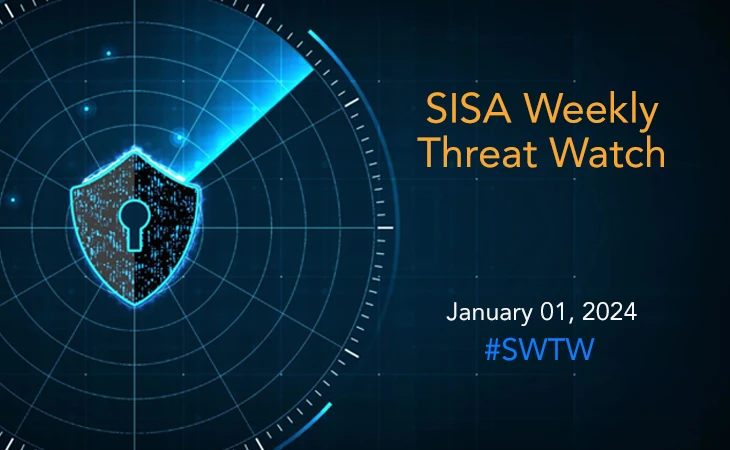Exclusive Insights
- The Critical Role of Managed Compliance in the Evolving Digital Payments Landscape
- The Rise of AI: A New Era in Cybersecurity Resilience
- Redefining Cybersecurity in a Fragmented Landscape: The Case for MXDR
- Cybersecurity Predictions and Trends for 2024
- Securing Tomorrow: Asia’s Digital Payment Transformation and the Road to 2024
- An American healthcare MNC strengthened its data security policy by integrating SISA Radar with DLP solutions
- SISA’s forensics-driven MDR solution helps Club Prophet improve monitoring of workloads on Google Cloud Platform
- SISA ProACT’s cloud-based MDR solution helps neobank improve real-time threat detection and response
- SISA helps a global cloud-based solutions provider mitigate IoT device vulnerabilities
Knowledge Lounge » Cybersecurity Predictions and Trends for 2024
Cybersecurity Predictions and Trends for 2024
Share on

2023 has been a whirlwind of a year! As I journeyed around the world and SISA immersed itself in various global events, we’ve had a plethora of eye-opening and thought-provoking chats with security experts everywhere. These discussions, combined with our in-depth market analysis and the insights gleaned from our unique in-house expertise, have deeply informed our perspective on the cybersecurity landscape. And let me tell you, our predictions for the future aren’t just crystal ball gazes; they’re grounded in solid evidence from our forensic investigations and internal research and intelligence teams. We’re looking at a future that’s brimming with both daunting challenges and exciting opportunities.
Now, as we venture into 2024, we’re about to witness a surge of trends that will significantly influence the cybersecurity narrative and dominate tech discussions:
AI as a Two-Way Street
Artificial Intelligence is set for a transformative year in cybersecurity for 2024, bringing both offensive and defensive capabilities. Malicious actors will wield AI for devious purposes like deepfakes and automated attacks, blurring the lines of reality. However, the good guys are fighting back with AI-powered real-time threat analysis, enabling quicker and more precise responses. Machine learning will further enhance defenses by automatically optimizing security measures. This AI revolution is happening amidst a global surge in regulations. Governments are scrambling to establish frameworks for responsible AI use, with the EU and US taking the lead. CISOs will need to adapt their strategies to navigate this complex regulatory landscape, prioritizing data security and compliance. To effectively leverage AI’s power while mitigating risks, organizations must implement robust data governance. This includes data classification, access controls, anonymization techniques, and regular audits. In conclusion, 2024 will be a year where AI plays a central role in the cybersecurity arms race. The onus will be on organizations to harness the immense potential of AI for defense while adhering to stricter regulations and prioritizing data security.
Digital Echoes of Geopolitical Strife
The cyber realm is becoming a new battlefield for international conflicts. The distinction between national cyber forces and criminal hackers is getting fuzzier, and this will likely lead to intricate cyber conflicts with worldwide repercussions in 2024. We can anticipate more frequent and sophisticated cyberattacks, especially those backed by nations, targeting crucial sectors. These attacks could disrupt vital services, steal sensitive data, or compromise key systems. To counter this, expect to see stronger collaboration across sectors and nations, as they join forces to tackle these advanced cyber threats.
Ransomware: A Growing Storm
The once siloed world of ransomware is exploding into a multifaceted threat landscape. As attackers target new frontiers like ransomware APIs, cloud services, edge computing, and the ever-growing network of IoT devices, the challenge is no longer just technical. We’re witnessing a “startup ecosystem” of ransomware groups emerge, with some established players facing takedowns by law enforcement. This paves the way for smaller, more covert groups wielding advanced tactics and aiming for bigger financial rewards. To combat this evolving threat, expect stricter regulations from governments and regulatory bodies. This could involve mandatory breach reporting, stricter data protection laws, and increased oversight of cloud service providers and IoT device manufacturers. In essence, 2024 is shaping up to be a year of not only a surge in ransomware attacks, but also a coordinated global response to fortify our defenses.
Securing the Internet of Things (IoT)
On another crucial front, there’s a significant and much-needed shift happening in IoT security standards. As IoT devices become increasingly integrated into essential systems – think Smart Cities – and start leveraging cutting-edge technologies like 5G and satellite connectivity, the industry is waking up to the critical need for solid cybersecurity measures. This isn’t just about implementing advanced encryption or stringent security protocols; it’s also about setting up continuous monitoring and real-time threat detection systems. Here’s where AI and ML step in, offering powerful tools to bolster our defenses in this ever-evolving landscape.
Embracing Integrated Cybersecurity
In 2024, enterprises are standing at a pivotal moment when it comes to cybersecurity. The core issue they’re grappling with is the siloed nature of their security tools. The temptation to pick the ‘best of breed’ solutions from various vendors has resulted in a fragmented security setup. This patchwork approach is riddled with integration challenges and runs the risk of missing critical alerts. It’s a scenario where the security landscape has become disjointed, leading to a surge in duplicate alerts and a ballooning workload for security teams, without a corresponding boost in actual security. Enterprises are now at a crucial juncture, reevaluating this path of accumulating multiple tools that offer diminishing returns. The shift we’re expecting to see is a strategic pivot towards a more consolidated approach, such as Managed Extended Detection and Response (MXDR), that can streamline threat detection and management, moving away from the clutter of disparate tools.
Cybersecurity Talent Shortfall
The cyber talent drought shows no signs of quenching, potentially jeopardizing over half of all major cyber-attacks by 2025. Organizations scrambling for qualified security professionals will have to think beyond traditional recruitment, forging partnerships and actively cultivating talent through expanded training avenues. A key solution is to enhance training initiatives, focusing not only on the quantity but also on the quality of the programs. Organizations will need to prioritize and invest in rigorous, industry-aligned programs and ensure they hire defenders equipped to navigate the increasingly complex cybersecurity challenges.
As I conclude the insights on the cybersecurity landscape of 2024, it’s also crucial to address the impact of tightened security budgets. Economic uncertainties are leading organizations to scrutinize their security expenditures more closely. CEOs, CSOs, and CISOs are increasingly collaborating to optimize budget allocations, focusing on risk prioritization and proactive security investments. This trend underscores the importance of reassessing risk assessments and involving all stakeholders in budgetary decisions. Amidst these constraints, it’s essential for security teams to refocus on core cybersecurity fundamentals: enforcing strong authentication, hardening systems, and maintaining vigilant security monitoring and vulnerability management. These steps are key to safeguarding data and ensuring safety in both physical and digital spaces, particularly when navigating budget limitations.
Exclusive Insights
- The Critical Role of Managed Compliance in the Evolving Digital Payments Landscape
- The Rise of AI: A New Era in Cybersecurity Resilience
- Redefining Cybersecurity in a Fragmented Landscape: The Case for MXDR
- Cybersecurity Predictions and Trends for 2024
- Securing Tomorrow: Asia’s Digital Payment Transformation and the Road to 2024
- An American healthcare MNC strengthened its data security policy by integrating SISA Radar with DLP solutions
- SISA’s forensics-driven MDR solution helps Club Prophet improve monitoring of workloads on Google Cloud Platform
- SISA ProACT’s cloud-based MDR solution helps neobank improve real-time threat detection and response
- SISA helps a global cloud-based solutions provider mitigate IoT device vulnerabilities
 USA
USA India
India APAC
APAC Middle East
Middle East Rest of the Countries
Rest of the Countries

 Facebook
Facebook Linkedin
Linkedin  Youtube
Youtube






